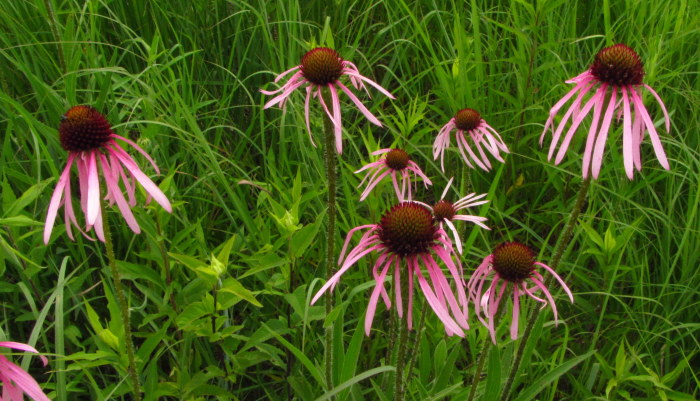By my count, Pale purple coneflower (Echinacea pallida) is the 200th wildflower species featured at Bleeding Heartland since I launched this series in 2012. (I’m not counting the sedges Leland Searles profiled or Eileen Miller’s posts about insects or unusual fungi.)
I’ve published more than 200 Iowa wildflower Wednesday posts, but some native plants have been the star of the show more than once. You can scroll through all posts tagged wildflowers in reverse chronological order, or click here for a full archive on one page, alphabetized by common name.
Pale purple coneflower seemed fitting for a milestone because it a striking plant in tallgrass prairie habitats, which used to cover most of Iowa. The species is native to about two dozen states in the East, South, and Midwest. I took most of the pictures enclosed below on Mike Delaney’s restored Dallas County prairie either a couple of summers ago or in late June 2019. When I visited again this week, the pale purple coneflowers were well past their peak, and some had finished blooming.
A related plant, Purple coneflower (Echinacea purpurea), is more popular in gardens and therefore a common sight throughout Iowa. Its original range only covered the southeast corner of the state. The Illinois Wildflowers website notes that compared to pale purple coneflower, purple coneflower has “broader leaves, [a] bushier habit, and later blooming period.”
The hairy stems on pale purple coneflower may stand out weeks before this plant blooms.
As with other members of the aster family, what appears to be one flower is a composite with ray floret (resembling petals) and small disk florets. Illinois Wildflowers describes the flowerheads as follows.
A single daisy-like composite flower develops at the top of the stem. It is about 3″ across, consisting of a prominent reddish brown cone of disk florets, which are surrounded by 12-20 light purple ray florets. The ray florets are long, slender, and droop downward. There is no noticeable floral scent. The blooming period occurs during early summer and lasts about 3 weeks, after which the ray florets shrivel away and the central cone turns black.
Many pale purple coneflowers have light pink ray florets.
Some are darker.
On some plants, the ray florets are almost white.
Masses of pale purple coneflowers were blooming in June. Unfortunately I didn’t have a wide-angle lens to do justice to this landscape.
Spring turns to summer: pale purple coneflower starting to bloom in the upper right corner of the frame. On the lower left, prairie phlox near the end of its blooming period. Yarrow (center) was going strong in late June when I took this picture.
The next two pictures show pale purple coneflowers near Beardtongue, also known as penstemon or foxglove.
In these more recent photos, the rays are looking a bit battered.
The ray florets have shriveled and will soon drop off this plant. You can see the cone getting darker.

















1 Comment
Pale Purple Coneflower is beautiful...
…so it’s really nice to see it chosen as the Iowa Wildflower Wednesday anniversary flower. Another reason it deserves the honor is because it is so popular with a variety of pollinators. Visitors include a number of bee and butterfly species, among them monarchs and the rare regal fritillary butterfly. I’ve read that even hummingbirds occasionally stop by.
A friend called pale purple coneflower “the puppydog plant” because of the way it faithfully follows fire. The blooms are often spectacular during the first growing season after a burn.
But I’ve never heard of this plant being too aggressive, which is not true of its cousin the purple coneflower. Of course as this post points out, purple coneflower only native to a small part of Iowa, but is now being planted all over the state. And many of the purple coneflowers being planted are commercial cultivars. So it’s not surprising that purple coneflower often doesn’t behave like a wild native plant in its native range.
It’s also beautiful, though. And it has become one of the marker plant species that indicate that an Iowa prairie is a planted reconstruction rather than an original.
PrairieFan Thu 25 Jul 2:42 PM